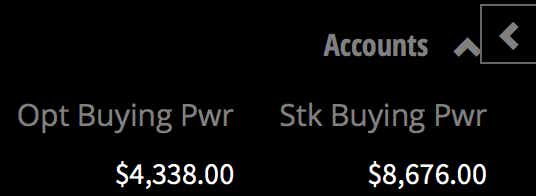What Is Options Buying Power?

What Is Options Buying Power?
By:Mike Butler
Buying power comes up in many options trading conversations, but what is it exactly and why is it important?
Buying Power Definition
Buying power (sometimes referred to as ‘excess equity’) as it relates to trading stocks and options, is the maximum amount of capital (money) available to make trades with.
As you fund your brokerage account and use your capital to place trades, your available buying power will change.

Buying Power Reduction
Buying power reduction refers to the amount of capital required to place trades and maintain them. Or phrased a different way, the amount of capital that will be tied up when purchasing stock or trading options.
Buying power reduction is hard to quantify as a whole because it really depends on the factors like the product being traded (i.e. stocks, options, future, etc.), the type of trade (defined risk v. undefined risk), and the type of brokerage account (margin, portfolio margin, IRA, etc.).
Here is a little more information about buying power as it relates to the type of brokerage account (it’s important to note that each brokerage has their own policies in regards to buying power on certain types of accounts – the below information will help you understand the differences between the account types, but the exact values may vary slightly from brokerage firm to brokerage firm).
Buying Power & Account Type
Non-Margin Buying power
In traditional IRA & Cash accounts, your stock and option buying power will be the same number. This is because there is no margin or leverage in an IRA or cash account when it comes to buying stocks. In this type of account, your gains and losses are 1:1, as your trades are all for cash value. For example, if you buy 100 shares of a $50 dollar stock, your buying power reduction will be the full amount; $5000.
IRA (Individual Retirement Account) Buying Power
In traditional IRA accounts, your stock and option buying power will be the same number. This is because there is no margin or leverage in an IRA account when it comes to buying stocks. In this type of account, your gains and losses are 1:1, as your trades are all for cash value. You can never lose more than the cash value of your account.
Margin Buying Power
In a standard margin account, you have 2:1 leverage when you buy stock and sell stock. This means that if you buy 100 shares of stock, your buying power will only be reduced by half of the notional value: 50 shares of stock. In an IRA account, buying power reduction of all 100 shares would be required. Margin essentially allows you to double your profits or double your losses, less commission fees and interest on the margin you borrow.
Portfolio Margin Buying Power
Portfolio margin takes your account one step further, and gives you about a 6:1 leverage for stocks. The calculation for buying power reduction is also a little different, as it bases the requirement around the largest projected loss for the day on all your positions. Volatility also plays into this calculation.
The minimum entry equity is $125,000 to obtain portfolio margin, and a net liquidity of $100k is required at all times. Portfolio margin can be revoked at any time.
Remember...
...that leverage allows you to magnify your gains, but it also magnifies your losses. It is very important to understand the mechanics of buying power reduction, and how it can affect your overall trading experience.
Calculating Buying Power For Options
Undefined Risk Trades
Calculating buying power isn't very difficult, but it can be different depending on what type of brokerage account you have.
Selling naked options in a margin account is a very popular strategy for options traders. Why? There is quite a bit of leverage using stock options in terms of buying power reduction. Because selling a naked option has higher risk than putting on a defined risk trade, buying power reduction is reduced based on the greatest of the following three formulas:
Consider the following scenarios for this trade:
Sell one 49 put for a $1.50 credit in XYZ, trading at $50.00
- 20% Rule - 20% of the underlying, less the difference between the strike price and the stock price, plus the option value, multiplied by number of contracts.
- Underlying Value: 20% x [$50.00 x (1x100)] = $1000
- OTM Amount: (49-50) x 100 = -$100
- Current Option Value: $1.50 x 100 = $150
- Buying Power Requirement: $1050
- 10% Rule - 10% of the exercise value plus premium value.
- Exercise Value: 10% x [49 x (1x100)] = $490
- Premium Value: $1.50 x 100 = $150
- Buying Power Requirement: $640
- $50 Plus Premium Value - $50 multiplied by number of contracts, plus premium value.
- $50 Value: $50 x 1 contract = $50
- Premium Value: $1.50 x 100 = $150
- Buying Power Requirement: $200
More often than not, option number one will be used because this number will generate the highest value. Higher buying power reductions give the broker more protection on the risk that they are taking with naked options, which is why they use the higher value.
So what about buying power reduction when you buy naked options? The buying power reduction when you purchase a naked option is equal the debit paid for the trade (there are no fancy formulas necessary to calculate this number).
Defined Risk Trades
Defined risk trades are also very simple in terms of buying power reduction calculations. Just like buying naked options, buying a debit spread requires a BPR of what you pay for the spread. Buying spreads will always cost less than buying the same long option because we are really just buying the naked option and reducing our cost basis by selling an option against it (commence AHA! moment).
Defined risk credit spreads have a different BPR calculation. For credit spreads, you will have to take the width of the spread and subtract the credit received to see what your BPR will be. For example, if we sell a 5-point wide (110/105) put spread and receive $0.50 in credit for it, our buying power reduction would be $450. (500-0.50 = 450).
Conclusion
Buying Power reduction can be tricky, but it is very important to understand how it works so you can optimize your trading experience and avoid those pesky margin calls!
Options involve risk and are not suitable for all investors. Please read Characteristics and Risks of Standardized Options before deciding to invest in options.
tastylive content is created, produced, and provided solely by tastylive, Inc. (“tastylive”) and is for informational and educational purposes only. It is not, nor is it intended to be, trading or investment advice or a recommendation that any security, futures contract, digital asset, other product, transaction, or investment strategy is suitable for any person. Trading securities, futures products, and digital assets involve risk and may result in a loss greater than the original amount invested. tastylive, through its content, financial programming or otherwise, does not provide investment or financial advice or make investment recommendations. Investment information provided may not be appropriate for all investors and is provided without respect to individual investor financial sophistication, financial situation, investing time horizon or risk tolerance. tastylive is not in the business of transacting securities trades, nor does it direct client commodity accounts or give commodity trading advice tailored to any particular client’s situation or investment objectives. Supporting documentation for any claims (including claims made on behalf of options programs), comparisons, statistics, or other technical data, if applicable, will be supplied upon request. tastylive is not a licensed financial adviser, registered investment adviser, or a registered broker-dealer. Options, futures, and futures options are not suitable for all investors. Prior to trading securities, options, futures, or futures options, please read the applicable risk disclosures, including, but not limited to, the Characteristics and Risks of Standardized Options Disclosure and the Futures and Exchange-Traded Options Risk Disclosure found on tastytrade.com/disclosures.
tastytrade, Inc. ("tastytrade”) is a registered broker-dealer and member of FINRA, NFA, and SIPC. tastytrade was previously known as tastyworks, Inc. (“tastyworks”). tastytrade offers self-directed brokerage accounts to its customers. tastytrade does not give financial or trading advice, nor does it make investment recommendations. You alone are responsible for making your investment and trading decisions and for evaluating the merits and risks associated with the use of tastytrade’s systems, services or products. tastytrade is a wholly-owned subsidiary of tastylive, Inc.
tastytrade has entered into a Marketing Agreement with tastylive (“Marketing Agent”) whereby tastytrade pays compensation to Marketing Agent to recommend tastytrade’s brokerage services. The existence of this Marketing Agreement should not be deemed as an endorsement or recommendation of Marketing Agent by tastytrade. tastytrade and Marketing Agent are separate entities with their own products and services. tastylive is the parent company of tastytrade.
tastyfx, LLC (“tastyfx”) is a Commodity Futures Trading Commission (“CFTC”) registered Retail Foreign Exchange Dealer (RFED) and Introducing Broker (IB) and Forex Dealer Member (FDM) of the National Futures Association (“NFA”) (NFA ID 0509630). Leveraged trading in foreign currency or off-exchange products on margin carries significant risk and may not be suitable for all investors. We advise you to carefully consider whether trading is appropriate for you based on your personal circumstances as you may lose more than you invest.
tastycrypto is provided solely by tasty Software Solutions, LLC. tasty Software Solutions, LLC is a separate but affiliate company of tastylive, Inc. Neither tastylive nor any of its affiliates are responsible for the products or services provided by tasty Software Solutions, LLC. Cryptocurrency trading is not suitable for all investors due to the number of risks involved. The value of any cryptocurrency, including digital assets pegged to fiat currency, commodities, or any other asset, may go to zero.
© copyright 2013 - 2025 tastylive, Inc. All Rights Reserved. Applicable portions of the Terms of Use on tastylive.com apply. Reproduction, adaptation, distribution, public display, exhibition for profit, or storage in any electronic storage media in whole or in part is prohibited under penalty of law, provided that you may download tastylive’s podcasts as necessary to view for personal use. tastylive was previously known as tastytrade, Inc. tastylive is a trademark/servicemark owned by tastylive, Inc.